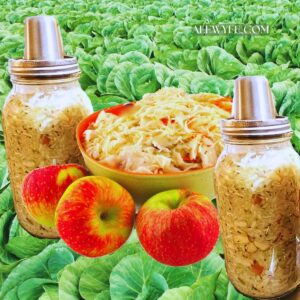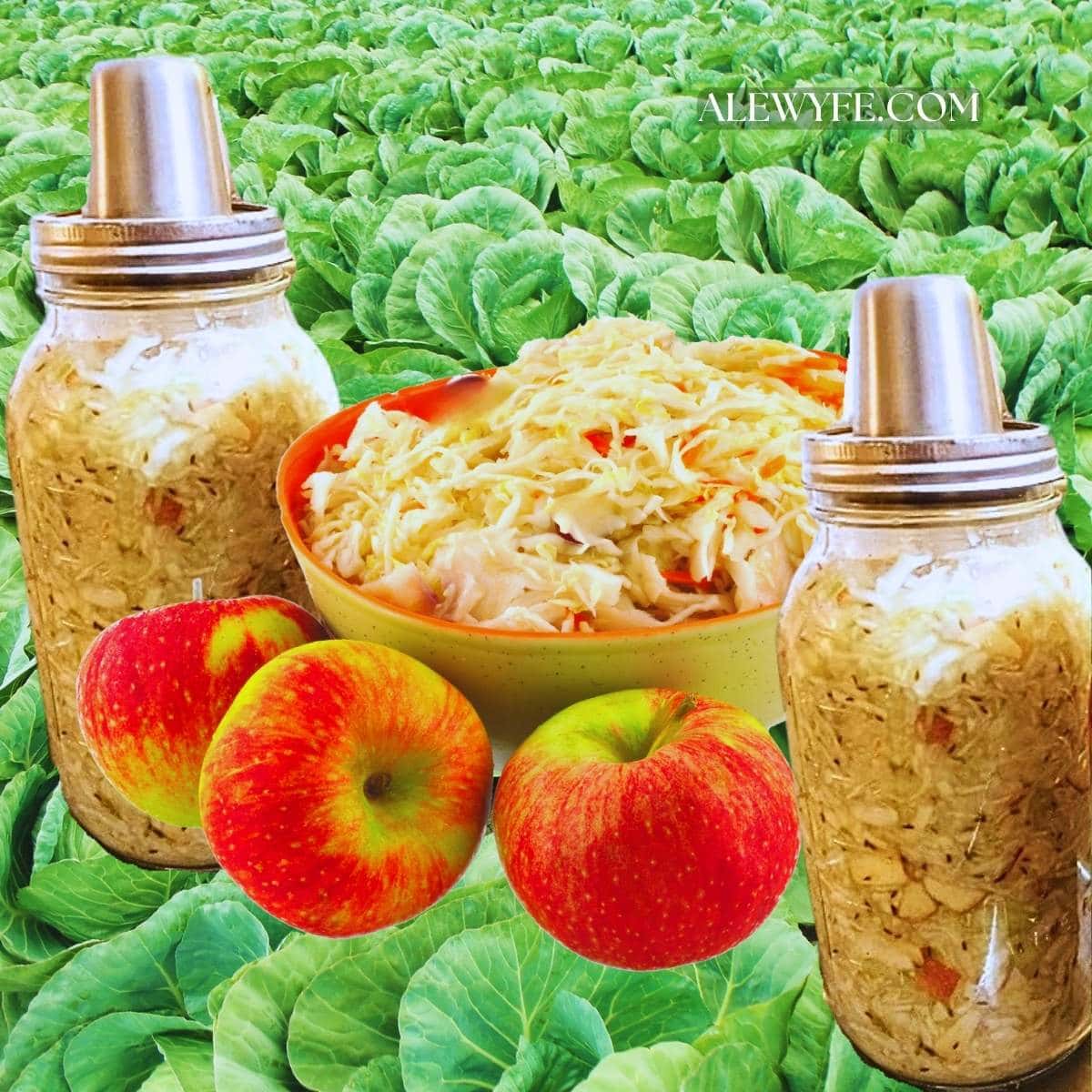FERMENT: How to Make Caraway-Apple Sauerkraut
- Ingredients for Caraway-Apple Sauerkraut
- Equipment & Method for Caraway-Apple Kraut
- FERMENT: How to Make Lactofermented Sauerkraut
- How to Use Your Caraway-Apple Kraut
- RELATED LINKS

This caraway-apple sauerkraut recipe, like all recipes, is really just a ratio. It will work with different ratios of cabbage to apple, but this one gives a nice flavor without being too sweet. A good guideline is three to four parts cabbage (cups, lbs, quarts, gallons… you can scale this to any size batch), to one part apples. Experiment in your kitchen and see what you prefer, but try the 4:1 mix first before you tweak it.
The most important ratio in this recipe is the salt to veg/fruit mixture, but we’ll cover that below and it’s not hard. You’ll want 2-3% salt to other ingredients… A scale will make this easiest and almost foolproof, but you can wing it if you don’t have one (or just like to live dangerously). To learn how to calculate this, go to our longer post on lactofermentation, or just follow the recipe below.
Ingredients for Caraway-Apple Sauerkraut
 Cabbage:
Cabbage:
Savoy or regular cabbage works here, either green or red. Green will give you a bright white or tan kraut that shows off the bits of apple and the contrast of the caraway seeds, but red makes a pretty pink kraut and has more antioxidants. It’s up to you… use what you have or try it both ways!
Apples:
Wash, quarter, and core your apples. You can leave the peels on (you might want to peel them if they’ve been waxed, or if you are using apples that you know were sprayed or aren’t organic). A tart, firm baking apple is best, but you can use sweet apples or a mix of varieties. Just before combining with your shredded cabbage, salt, and other seasonings, shred, grate, or finely chop your apples into small pieces.
Salt:
You can use kosher salt, canning and pickling salt, or sea salt here. Avoid iodized salt for best flavor. For perfect results, you need a scale. Use two to three percent salt by weight. Weigh your total vegetables and fruit (after peeling & coring)… convert to ounces, and multiply by 0.02 to determine your salt, by weight. You can wing it with a few tablespoons per layer and tasting the final product to make sure it’s salty enough to ferment without spoiling (or TOO salty to ferment properly or taste good), but until you are familiar with the process it’s best to weigh your ingredients and take out any guesswork! Plus different types of salt have very different volume measurements. A tablespoon of kosher salt weighs a lot less than a tablespoon of fine sea salt! You can find conversion charts online but get a scale if you can!
Caraway, ginger, chili, or other optional seasonings:
You can leave your cabbage-apple kraut plain, or spice it up! I often like to add freshly grated or frozen ginger, garlic, chili flakes, crushed pink peppercorns, or mustard seeds along with the caraway seeds… just not all of the above! Stick with one or two compatible flavor add-ins until you are familiar with the process, then mix it up and get as wild as you like! A good ratio is one or two teaspoons per quart, or up to a few tablespoons per half-gallon batch.
Equipment & Method for Caraway-Apple Kraut
If you haven’t made sauerkraut before and aren’t already familiar with the equipment and techniques, check out our introductory post to learn more about the best and easiest ways to make sure your batch of caraway-apple kraut is a success.
While you can buy beautiful dedicated fermentation crocks if you get into making these as a hobby, you can get started with just some basic supplies. You might already have everything you need in your kitchen!
FERMENT: How to Make Lactofermented Sauerkraut
Sharp knife & cutting board, box grater, slaw board or mandoline, or food processor with grater & shredder plates
Large mixing bowl or clean food-safe bucket
Kraut tamper, wooden french rolling pin, wooden dowel, etc
Wide Mouth mason jars or fermentation crock
Pickle weights, plastic bag filled with brine, or a plate that fits in your crock under the lid
Mason Jar lids with Airlocks, “Pickle Pipes”, or Plastic jar lids
Kitchen Scale (analog or digital)
How to Use Your Caraway-Apple Kraut
This sweet-tart crunchy condiment is great wherever you would use kraut, but I especially like it paired with:
- Roasted pork loin
- Grilled or Southern-fried pork chops
- Beef or venison sauerbraten
- Pork, veal, or venison schnitzel
- Potato & Cheese Pirogi
- Bacon & Venison Liver Pirogi
- Crispy Potato Cakes or Zucchini Fritters
- Yooper (ish) Pasties with Venison and Roasted Root Vegetables and Spent Grain Butter Crust
- Venison Leberknödel- How to Make German Liver Dumplings
- Wild Game Charcuterie- Homemade Venison Wiejeska (Fresh Kielbasa with marjoram)
- Bratwurst or Sweet Italian Sausages

Caraway Apple Sauerkraut
Ingredients
- 1 ½ lb shredded cabbage 1 lb 12 oz
- ½ lb ripe apples washed, cored, and chopped or grated
- 2 tbsp caraway seeds or to taste
- 2 tbsp kosher salt
Instructions
- Remove any wilted outer leaves from the cabbage. Wash, core, quarter, and weigh the cabbage and record weight (if more or less than 2 lbs). Wash and core the apples. You can leave the peels on, unless they are not organic or have been waxed, when you might prefer to peel them.
- Shred or slice the cabbage and apples finely using a knife and cutting board, a box grater, mandoline, slaw board, or food processor.
- Mix the cabbage, apple, caraway, and salt in a large mixing bowl or food-safe bucket. Massage and mix well with tongs or clean hands... the salt will pull moisture from the cabbage as it sits.
- Carefully pack the shredded cabbage and salt mixture into clean and sanitized mason jars, fermenting crocks, or a food safe bucket with a lid and airlock. Tamp down well to release as much trapped air as possible.
- If the cabbage-apple mixture has not released enough liquid to cover itself, add a bit of water to top up the brine mixture. Weight down the top of the jars with pickle weights, a clean plate, or a sealed bag of light brine (salt + water, so if it leaks it will not dilute your brine solution).
- Cover with a lid and airlock, or a loosely fitting lid and cloth. Check the airlock daily and clean it and top up with brine or boiled and cooled water as needed to maintain a liquid seal in the airlock during fermentation. Place the jars somewhere cool and out of direct sunlight- 50-75℉ is fine, with 65-70℉ being ideal. You can ferment in warmer temperatures if you must, but increase the salt slightly, and the texture of the kraut may be mushy if it's too hot or develop off-flavors.
- Most fermentations will finish within 7-14 days. If you will be canning this, it's best to let it go the full 2 weeks. If you will be storing it in the fridge, you can taste and check for sourness and consistency. When it tastes the way you want it, cap with a regular lid (plastic or stainless is best, as metal jar rings tend to rust quickly if they come in contact with the brine). Store in the fridge (best/safest) or a cool root cellar or pantry.
